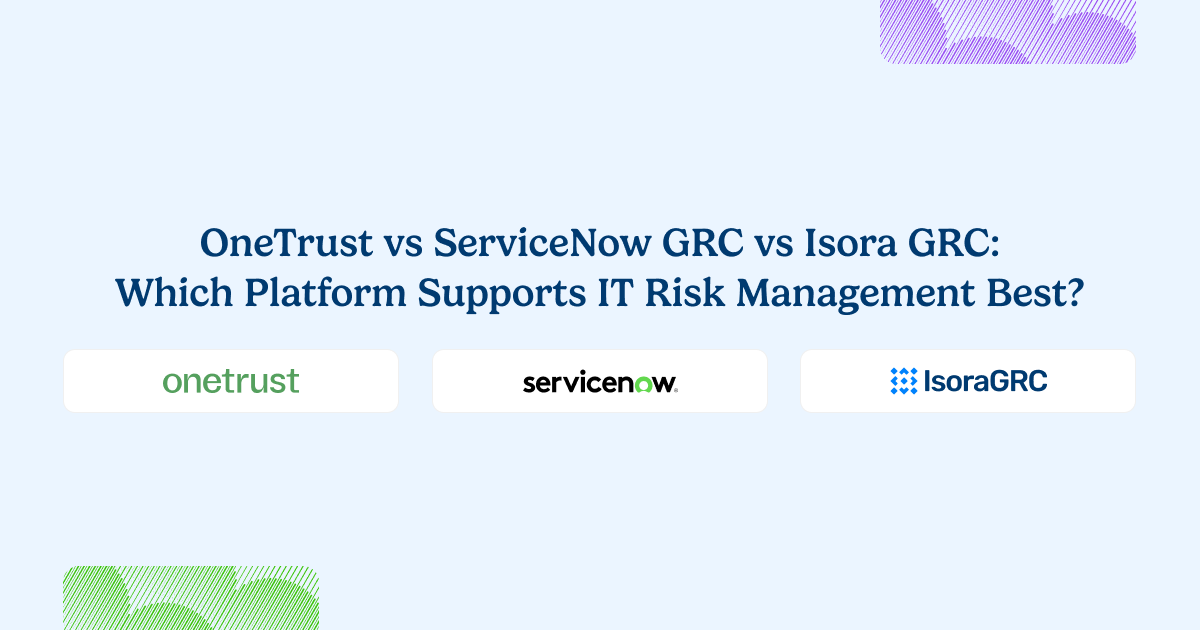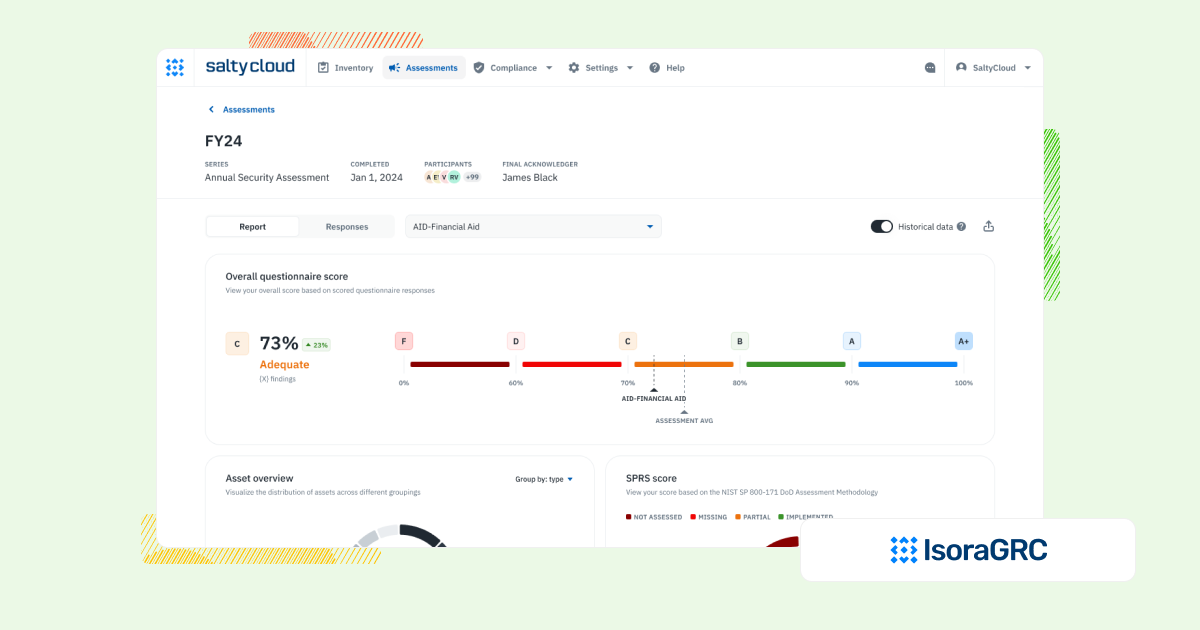
Every security team needs a platform that supports their work, not one that slows it down.
OneTrust and ServiceNow GRC are well-known all-in-one platforms designed to support a wide range of governance, risk, and compliance use cases. But for security teams focused on IT and third-party risk, these tools often introduce more friction than flexibility, requiring complex configuration, heavy support from other teams, and workarounds to handle everyday tasks.
When platforms are designed to serve every department, they rarely serve security well. The result: low adoption, bloated processes, and delayed risk decisions.
Isora GRC takes a more focused approach. It’s built specifically for security teams—helping them manage assessments, inventories, and risk registers with clarity, speed, and collaboration baked in.
Let’s break it down.
Choosing the Right Platform for IT Risk Management
OneTrust and ServiceNow GRC are enterprise platforms with expansive functionality, but that breadth can come at the cost of usability. They prioritize department-wide configurability, which often means long implementations, disconnected modules, and workflows that don’t reflect how security teams manage risk day to day.
Isora GRC was purpose-built for IT and third-party risk management. It delivers structured, repeatable workflows—assessments, vendor and asset inventories, exception tracking, and risk registers—without the overhead. It’s fast to deploy, easy to use, and built for adoption across technical and non-technical teams.
The Workflow That Matters: Managing IT Risks and Compliance
IT risk management isn’t static—it’s an ongoing, collaborative process. Security teams need to assess internal departments and vendors, collect responses, manage inventories, identify risks, and track remediation across business units.
That requires tools built for coordination, visibility, and speed. Many all-in-one GRC platforms weren’t designed with that kind of hands-on, iterative work in mind. Their complexity slows everything down and makes it harder to involve the people closest to the risk.
Isora GRC unifies these workflows in a single, intuitive platform—so teams can focus on reducing risk, not managing tools.
How Each Platform Supports IT Risk Management Workflows
| Workflow Area | OneTrust | ServiceNow GRC | Isora GRC |
| Assessment Management | OneTrust helps with assessments, but users often face trouble with workflows. Many steps stay manual, slowing down teams. Custom options feel limited, so changing forms for your needs gets tricky. | ServiceNow GRC handles assessments, but setup takes time. Custom changes need skilled help, which can slow things down and raise costs. | Centralized, intuitive assessment dashboard across business units, vendors, and assets. Built specifically for security teams. |
| Questionnaire Delivery & Completion | Surveys work in OneTrust, but the layout feels complex. Staff may need time to learn the system. Custom tools for forms don’t match what some other platforms give, so flexibility stays low. | Survey tools work, but the layout feels clunky for new users. Learning takes time, and some teams may avoid using the tools. | Customizable and prebuilt questionnaires for frameworks like NIST, ISO, GLBA, HIPAA, and more. Designed for internal and external collaboration. |
| Inventory Tracking | Inventory tools feel basic. Teams with many assets may not get enough depth. The risk log also needs work, and links to other tools stay weak. | Connecting ServiceNow GRC to old systems brings trouble. Upgrades may cost extra and slow the shift to the new system. | Centralized tracking of assets, vendors, and organizational units with integration support for existing data sources. |
| Risk Register & Exception Management | The risk log works but may not fit every workflow. Some teams must add code or extra steps to adjust it. Handling exceptions takes effort and may pull in more staff time. | Risk and exception tools run strong, but setup stays tough. Managing these tools may need extra teams, pulling time and money. | Flexible, collaborative risk register with scoring, status, evidence, and ownership tied directly to assessments. Exception management is built-in and intuitive—no extra modules or configuration required. |
| Scoring, Reporting & Risk Visualization | OneTrust gives charts and reports, but many users find the layout confusing. Learning the system takes time. Reports feel harder to use than some others, which may slow down analysis. | Reports in ServiceNow can be tricky. Pulling data from different sources and making custom reports takes effort. This may slow down decisions. | Automated scorecards, risk maps, and executive-friendly reports with actionable insights—no manual config required. |
| Collaboration & User Experience | Using OneTrust can feel tough without tech skills. The layout may turn off new users. On the plus side, free online training and badges can help staff learn faster. | The layout feels heavy and hard to use. Learning takes time, so teams may need extra training to feel confident. | WCAG-compliant, award-nominated interface with built-in commenting, team workflows, and fast onboarding. |
| Implementation & Setup | Getting OneTrust up and running takes time. Setup and moving data need strong teams and resources. Small teams may struggle due to cost and effort. The price can also block smaller businesses. | Setting up ServiceNow GRC takes time, people, and money. License costs run high. Old systems may block a smooth shift and force more tech upgrades. | No-code setup in days or weeks. Minimal IT lift required. Designed to go live quickly across teams and vendors. |
What Sets Isora GRC Apart?

Isora GRC was purpose-built for information security teams—designed to support the real workflows behind risk and compliance, not just generate reports. While legacy GRC platforms require months of configuration and rigid processes, Isora takes a modern, scalable approach:
- Purpose-built for security and third-party risk teams
- No extra modules or cross-department bloat—just the workflows that matter.
- Easy for anyone to use
- Clean UI, no complex training, and built to drive adoption across the org.
- Streamlined for action, not just documentation
- Assessments, questionnaires, inventories, risk tracking, and reporting—all in one place.
- Fast, no-code implementation
- Go live in weeks, not quarters, with minimal IT lift.
- Scales with your program
- Whether you’re running a lean risk function or supporting a large institution, Isora grows with you—without getting in the way.
Who Each Platform Is Best For
| Platform | Who It’s For |
| OneTrust | Teams focused on privacy, third-party checks, and sustainability. Works fast but leans more toward privacy than InfoSec. |
| ServiceNOW GRC | Companies already using ServiceNow. Helps tie risk and compliance into other business tools, but often feels built more for IT than security. |
| Isora GRC | Security teams that need a scalable, usable IT risk management program across their organization. |
What Our Customers Say About Isora GRC
Security teams at top institutions are using Isora GRC to replace legacy tools and manual processes with intuitive workflows and actionable insight.
“Moving from manual processes to using Isora was a breath of fresh air. What used to take months is now automated, reliable, and defensible. Isora saves us significant time while delivering accurate insights that improve decision-making.”
Jessica Sandy, IT GRC Manager, The University of Chicago
“Isora has been essential in helping us meet our University of California cybersecurity requirements across a decentralized campus. Automating assessment data collection and reporting has given us clear visibility into unit-level risks, enabling us to prioritize resources effectively and address gaps with confidence.”
Allison Henry, CISO, The University of California, Berkeley
FAQs
What’s the difference between OneTrust, ServiceNow GRC, and Isora GRC?
OneTrust and ServiceNow GRC are broad platforms designed to support many GRC functions across departments. Isora GRC focuses specifically on information security—making it easier for teams to manage assessments, asset inventories, and IT risk without unnecessary complexity.
Are OneTrust and ServiceNow GRC considered all-in-one GRC tools?
Yes. These platforms aim to serve privacy, legal, audit, and compliance teams alike. That often means more configuration, steeper learning curves, and workflows that don’t fit the day-to-day needs of security teams.
Does Isora GRC replace tools like OneTrust or ServiceNow GRC?
In many cases, yes. Security teams turn to Isora GRC when they need to streamline risk assessments, improve adoption, and focus on IT and third-party risk without wading through non-relevant features.
Which platform is best for managing IT risk across the organization?
Isora GRC is built specifically for IT and vendor risk workflows. OneTrust and ServiceNow GRC offer wide functionality but can feel overly complex for security-specific tasks like collaborative assessments or inventory-driven risk management.
Can I use Isora GRC alongside an enterprise GRC platform like OneTrust?
Yes. Some organizations use Isora GRC to manage risk at the operational level while retaining OneTrust or ServiceNow GRC for legal or audit workflows. Others fully transition to Isora for a simpler, more focused approach.
What should I look for in a GRC platform for IT risk management?
Look for ease of use, collaboration, and purpose-built workflows for security teams. Platforms like Isora GRC support assessments, inventories, risk tracking, and exception management—without overcomplication or reliance on IT to get started.



















 Other Relevant Content
Other Relevant Content